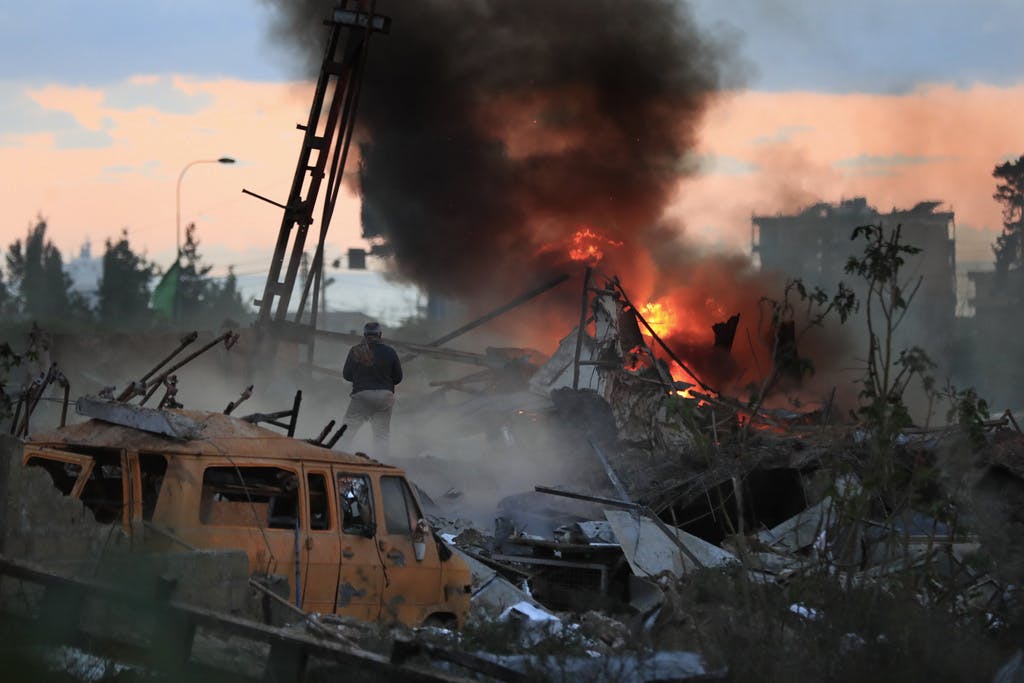Even as the Conflict at Gaza Rages, Israel Turns a Wary Eye North to ‘the Real Threat’
‘Israel is more willing than Hezbollah to take risks, and that is a major advantage we have,’ an Israeli Mideast watcher says.

As America and the rest of the world eye Gaza, is it time for Israel to concentrate most of its military and diplomatic efforts on a more acute, but globally ignored danger — the threat from Iran’s most powerful proxy, Hezbollah?
“The north is the real story,” a former Israeli cabinet secretary, Zvi Hauser, tells Channel 11 Tuesday. As he speaks, as if by invitation, the news channel posts on one corner of the screen a “red alert.” A barrage of more than 50 Hezbollah rockets was launched at Israeli communities near the Lebanese border and the Golan Heights.
That salvo is the latest act in a series of events since Monday night — part of the tit-for-tat skirmish between Israel and Hezbollah. Since the Lebanon-based terrorist organization launched a low-intensity war on Israel following the October 7 Hamas attack, some 70,000 residents of northern Israel were forced out of their homes, as were up to 100,000 residents of southern Lebanon.
On Monday night, Israeli jets conducted an air attack deep inside Syria, near the Iraqi border. Several Iranian and Hezbollah operatives, who were reportedly preparing arms deliveries to the West Bank, were killed. Syrian press cited Hezbollah sources who blamed America for the attack. The Pentagon denied involvement.
On Tuesday, Hezbollah aimed its missiles at a well-defended Israeli Defense Forces northern command post on the Meron mountain, reportedly with no significant damage. Israel then hit a Hezbollah arms factory in northern Lebanon. The hit — 112 miles from the Israeli border — marked the farthest IDF attack into Lebanon yet.
Tuesday’s Hezbollah retaliation that triggered red alerts on Israeli television screens was larger than usual. Yet, it is the Israel Defense Force that seems to initiate escalatory attacks.
“Israel is more willing than Hezbollah to take risks, and that is a major advantage we have,” a Mideast studies professor emeritus at Haifa University, Amatzia Baram, tells the Sun. Both sides, he says, would suffer tremendously if daily skirmishes escalate into an all-out war. Yet, Israel is willing to risk it, as it cannot allow Hezbollah to empty out the Galilee.
As Lebanon suffers unprecedented economic and political crises, on the other hand, the status of Hezbollah’s leader in Lebanon, Hassan Nasrallah, is declining. He cannot afford to be responsible for a war that would completely destroy Lebanon.
While Israel doesn’t seek an all out war, “we must escalate in order to force tacit understandings with Hezbollah,” Mr. Baram says. Backed by America and Lebanon’s former colonial power, France, such unwritten pacts would be based on UN Security Council Resolution 1701, which ended the 2006 Israeli-Hezbollah war.
That resolution, in part, ordered Hezbollah to stay north of Lebanon’s Litani River, 18 miles from the Israeli border. Initially, Hezbollah forces indeed stayed out of that zone. Yet, at the height of the organization’s power grab over the country, it returned, taking control of the entire border area. Hezbollah’s elite Radwan force was undeterred by the presence of UN peacekeepers.
Shortly after Hamas launched its October 7 attack and Hezbollah decided to join by firing at Israeli towns, Beirut’s Sunni prime minister, Najib Mikati, visited the south. He went there, he said, “to reaffirm peace-loving Lebanon’s respect for all legitimate international resolutions,” including resolution 1701.
An increased military pressure on Mr. Nasrallah could force him to agree, and move his forces away from the Israeli border. After that, Mr. Baram says, “Israel must make clear that it would not allow Hezbollah to return, as in the years after 2006, and that the IDF would strike hard at any armed militia men near the border ”
In his television interview, Mr. Hauser said that Israel must soon wind down its Gaza operation — “and then concentrate on where the real threat is, in the north.”
Hezbollah is the sharpest arrow in the Islamic Republic of Iran’s quiver. With up to 150,000 rockets, including highly accurate and mid-range missiles, the Lebanese terror group has the capacity to hit any target in Israel. Loath to lose its most potent proxy army, Iran is constantly warning Mr. Nasrallah against getting into an all-out war with Israel.
While the world concentrates on the suffering of Gazans, the plight of northern Israelis is widely ignored. Meanwhile, Iran’s “ring of fire” — the Houthis, Hezbollah, Hamas, Syrian and Iraqi militias, and others — feel emboldened as Washington’s support of Israel’s war against Hamas weakens.
Following America’s decision Monday to forgo vetoing a UN resolution, Hamas chief Ismail Haniyeh visited Tehran, where he received a red carpet reception. “Israel is failing militarily, and now it is also losing its international umbrella,” Mr. Haniyeh told eager reporters.
That dynamic could change if even as Israel continues its efforts against Hamas, it now turns its attention, and that of the world’s, to the northern border. After all, the UN already resolved that skirmish back in 2006. What is needed now is to implement that resolution.

